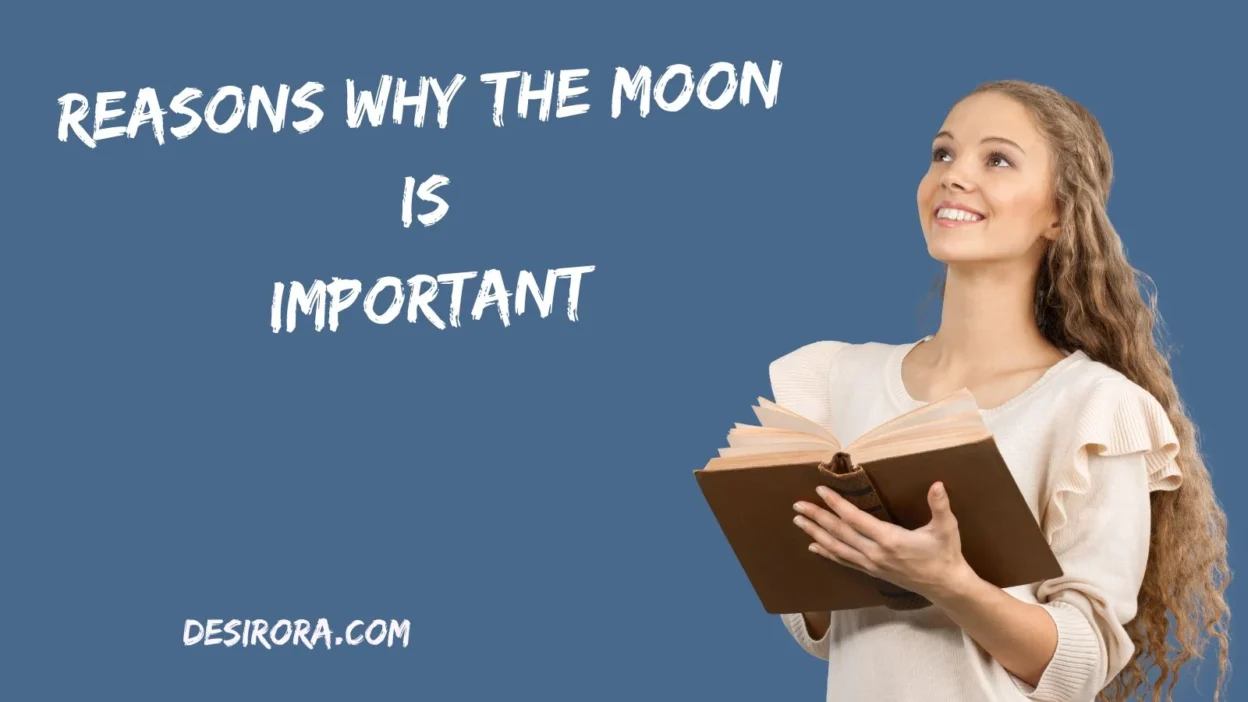The Moon has always fascinated humankind. From ancient myths and poetry to modern science and space exploration, this glowing sphere in the night sky has captured our imagination for thousands of years.
But beyond its beauty, the Moon plays a powerful role in keeping Earth stable and life thriving. It influences our oceans, climate, seasons, and even the rhythms of plants and animals. Without it, our world would look—and function—very differently.
In this article, we’ll explore the many reasons why the Moon is important, uncovering how it shapes our planet, supports ecosystems, inspires culture, and guides our journey toward the future.
What the Moon Does for Earth’s Climate and Seasons
When we think of the Moon, we often picture a glowing orb in the night sky or a romantic backdrop for stories. But in reality, the Moon is one of Earth’s greatest stabilizers.
Stabilizing Earth’s Tilt and Seasons
The Moon’s gravitational pull keeps Earth’s axial tilt steady at about 23.5 degrees. That tilt gives us our familiar seasons—spring, summer, autumn, and winter. Without the Moon’s influence, our tilt could shift dramatically over time, leading to chaotic seasons and extreme climate changes.
Imagine a world where summers last for decades and winters freeze entire continents. Life would have a hard time adapting. Thanks to the Moon, our seasons remain balanced, creating the stable environment that allows plants, animals, and humans to thrive.
Helping Maintain Climate Balance
Because the Moon stabilizes Earth’s spin, it helps prevent major temperature swings. Stable seasons mean more predictable weather patterns, allowing ecosystems to flourish. This stability has been crucial for evolution and agriculture alike.
A Simple Example
Think about two planets: one with a large moon and one without. The planet with a moon enjoys mild shifts between warm and cool seasons, while the other experiences unpredictable climate swings. The Moon’s presence makes Earth’s climate far more livable.
The Moon’s Role in Ocean Tides, Wildlife and Ecosystems
The Moon’s gravitational pull affects our oceans every single day, creating high tides and low tides. These movements are more than just beautiful—they’re essential for life.
Ocean Tides and Water Circulation
Tides caused by the Moon help mix ocean waters, move nutrients, and regulate temperatures. Without them, marine ecosystems would stagnate. Nutrient circulation supports plankton, fish, coral reefs, and countless other species that rely on this movement.
Tides also help clean coastal areas by preventing water from becoming stagnant, ensuring the health of shoreline ecosystems.
Influence on Wildlife
Many creatures, both in the ocean and on land, rely on the Moon’s cycles for survival:
- Sea turtles lay their eggs according to the lunar calendar.
- Fish and corals spawn in sync with full or new moons.
- Migratory birds and certain insects use the Moon’s light for navigation.
In this way, the Moon acts like a natural clock, guiding behaviors that are essential for reproduction, feeding, and migration.
Ecological Summary
| Natural Element | Moon’s Influence | Importance |
| Tides | Caused by lunar gravity | Supports ocean mixing and nutrient distribution |
| Coastal Life | Intertidal zones created by tides | Habitat for diverse species |
| Wildlife Cycles | Lunar phases guide reproduction and movement | Ensures ecosystem balance |
Even small changes in the Moon’s distance could affect tidal strength, impacting entire food chains.
The Moon and Time: Calendars, Light and Human Culture
Beyond its physical influence, the Moon has guided humanity’s sense of time, rhythm, and art for thousands of years.
Lunar Calendars and Timekeeping
Before modern clocks, people tracked time by observing the Moon’s phases. A complete lunar cycle—from new moon to full moon and back—takes about 29.5 days. That’s how the word month originated.
Many ancient calendars, including those used in Asia and the Middle East, are still based on the Moon’s cycles. Festivals, farming seasons, and religious observances often follow lunar timing.
The Moon as Night Light
Before electricity, moonlight was one of the few natural sources of light at night. It allowed people to travel safely, gather, hunt, or fish under its glow. Even today, moonlit nights influence behavior—both human and animal.
Cultural and Artistic Importance
The Moon has inspired countless myths, songs, and works of art. It symbolizes mystery, romance, and change.
- Poets write about it as a mirror of emotions.
- Painters capture its glow to evoke calm or longing.
- Cultures around the world celebrate it through festivals like the Mid-Autumn Festival, Harvest Moon, and Eid.
The Moon connects us through shared wonder—it’s one of the few celestial bodies everyone sees regularly.
Protecting Earth, Shaping the Day Length and Stabilizing Our Planet
The Moon’s importance doesn’t stop with tides and light—it’s also responsible for the length of our days and even for protecting Earth in subtle ways.
Lengthening the Day
Billions of years ago, Earth spun much faster, completing a full rotation in about 21 hours. Over time, the Moon’s gravitational pull has gradually slowed our rotation. This process lengthens our days by tiny fractions of a second each century.
That slower spin gives life more time to adjust between day and night, balancing temperature changes and supporting a stable environment.
Planetary Shielding
While the Moon doesn’t act as a perfect shield, it has absorbed many asteroid impacts that might otherwise have hit Earth. Ancient craters on the lunar surface show its long history as our silent guardian.
Long-Term Stability
By stabilizing Earth’s tilt, moderating its rotation, and influencing climate and tides, the Moon helps create conditions that have allowed life to thrive for billions of years. Without it, Earth might be a far harsher, more unstable planet.
Real-Life Uses: Science, Space Exploration and Everyday Inspiration
Scientific Value
The Moon holds the key to understanding how Earth and other planets formed. Rocks and dust samples collected from its surface have revealed clues about our solar system’s history. Because there’s no atmosphere or weather to erode them, the Moon preserves a record of billions of years of cosmic events.
Scientists also plan to use the Moon as a base for further exploration. Its surface could one day host telescopes, observatories, or even refueling stations for spacecraft heading deeper into space.
Gateway for Space Exploration
The Moon serves as humanity’s training ground for Mars and beyond. Building bases on the lunar surface teaches us how to survive with limited resources, produce energy, recycle water, and protect against radiation.
Many space agencies view the Moon as a critical stepping-stone for future missions. It’s close enough for testing but far enough to push human innovation.
Everyday Inspiration
The Moon continues to influence our daily lives:
- Education: It sparks curiosity in astronomy and science among students.
- Tourism: People travel to observe supermoons, eclipses, and meteor showers.
- Technology: Lunar research has led to advancements in robotics, materials science, and energy systems.
The Moon’s presence constantly pushes humanity to explore, imagine, and discover.
Types of Importance: Scientific, Ecological and Cultural
| Type | Description | Why It Matters |
| Scientific | Offers insights into planetary formation, space science, and exploration | Helps understand Earth’s origins and future |
| Ecological | Controls tides, stabilizes climate, affects wildlife | Keeps ecosystems healthy and predictable |
| Cultural | Shapes calendars, art, myth, and human imagination | Connects people emotionally and spiritually |
The Moon’s importance spans science, nature, and culture. It ties together the physical and emotional sides of life on Earth.
How the Moon’s Value Helps Us in the Future
Understanding Climate and Habitability
Studying the Earth-Moon system helps scientists predict how planetary systems evolve. This knowledge may guide the search for habitable worlds elsewhere.
Future Space Economy
The Moon could provide valuable resources such as water ice (for fuel and drinking), minerals, and even solar energy. Lunar mining could one day support sustainable space exploration.
Human Settlement Beyond Earth
Building lunar bases will teach us how to live sustainably in harsh environments—skills that could also help us manage resources better here on Earth.
Inspiring Global Cooperation
Space exploration has always brought nations together. The return to the Moon symbolizes unity, progress, and the shared dream of exploration.
FAQs
Q1: Would Earth survive without the Moon?
Not immediately catastrophic, but over time Earth would become less stable. Our tilt could wobble wildly, seasons would change unpredictably, and tides would weaken—disrupting ecosystems and climate.
Q2: Does the Moon only affect tides?
No, it also stabilizes Earth’s rotation, influences biological rhythms, and shapes climate. Its effects reach every part of life on Earth.
Q3: How does the Moon affect human culture?
It inspires art, music, literature, and festivals. The Moon’s cycles have guided calendars, agriculture, and even beliefs about life and time.
Q4: Can we live on the Moon someday?
Possibly. Scientists are researching how to build habitats that use lunar resources. Living there would be challenging, but it’s a key step toward becoming a space-faring civilization.
Q5: Why is the Moon important to science?
It’s like a time capsule of the early solar system. Studying it helps scientists understand how planets form, evolve, and sustain life.
Conclusion
The Moon isn’t just Earth’s satellite—it’s our planet’s silent partner in every sense. It stabilizes our climate, guides our oceans, influences life cycles, and fuels our curiosity. It has shaped human culture, inspired exploration, and continues to drive scientific discovery.
Without the Moon, life as we know it would be very different. From the gentle pull of tides to the glow that lights up our nights, its impact is woven into every aspect of existence.
As we look to the future—toward lunar colonies and deep-space missions—it’s clear that the Moon will remain our steadfast companion, reminding us that even in the vastness of space, connections matter.




